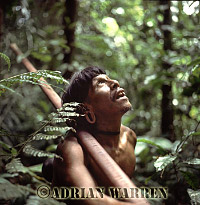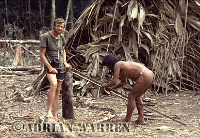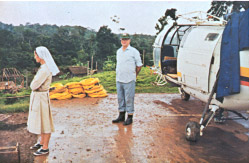WAORANI
The Saga of Ecuador's Secret People:
A Historical Perspective
© Adrian Warren, Last
Refuge Ltd., March 2002, in association with Dr. James Yost

Caempaede hunting with Blowgun, 1983
 Caempaede and Jim Yost,
1983
Caempaede and Jim Yost,
1983 |
Jim
knows that tourists often brag that they had "no impact"
upon the Waorani, because they left nothing behind, but such simplistic
notions are foolish. Those who deny the typical tourist pocket
knife, backpack, camera or clothing establish a sense of self-deprivation
among the Waorani, one that motivates them to seek those goods
at all costs, even at the cost of a traditional way of life. All
contact carries consequences, some bad, some good; only those
who are sensitive enough to be aware of that fact can take steps
to try to ensure that their impact is more positive than negative.
|
By 1985, the traditional way of
life had almost disappeared, with the exception of Tagae's group, who
were still living in secret isolation, somewhere along the Curaray river.
Their days were numbered though as the outside world encroached on traditional
Waorani lands from all sides. Oil companies, colonists, missionaries,
and travelers threatened the privacy that Taga's group sought to maintain.
In 1987, two Ecuadorian missionaries with several years' experience working
among Waorani communities, Capuchin priest Padre Alexandro La Baca and
Nun Ines Arango, hoped to contact Tagae's group before the devastation
brought by oil exploration drove them to extinction, or into violent confrontations
with oil men. In full knowledge of Tagae's fearsome reputation, and the
fact that no one who had approached them had ever come out alive, the
two missionaries were dropped by an oil company helicopter close to Tagae's
settlement. Two days later, the air crew returned to find the dead bodies
of both. They had been speared to death. It was predictable, perhaps,
but at the same time tragic. Reprisals by the oil companies or the military
were feared, and indeed may have happened. For Tagae's group, the writing
was on the wall.

Sister Ines Arango and Padre Alejandro
La Baca
just before attempting contact with the Tagaeidi, 1987
Pressure from outsiders continued to increase,
driven by a relentless thirst for oil. Dramatic changes were enveloping
the Waorani; the oil companies seemed unstoppable, timber harvesters were
felling trees within the boundaries of their hunting grounds, diseases
the Waorani never knew were challenging their health, and Spanish schools
were keeping children out of the forest and teaching that the traditional
Waorani ways were of no value.
Numerous outsiders, particularly Quichua and Shuar,
were assuming the role of spokespersons on behalf of the Waorani around
1981, usually without the Waorani even being aware they were doing so.
These "spokespersons" were representing the Waorani to the Ecuadorian
government, to oil companies, to international aid organizations and to
the media. At times they obligated the Waorani to things they had no knowledge
of and at other times they made "requests" on behalf of the
Waorani and then made off with the funds or whatever they could glean
by doing so - again without Wao knowledge of it. The younger Waorani who
were learning Spanish and outside ways began to realize what was happening
and decided it was time to organize themselves so they could be their
own representatives to the outside world. The last project Jim Yost undertook
before he left Wao land in 1982 was to spend 6 months travelling from
village to village talking to the Waorani about leadership issues - explaining
to them about representative government, legal organization, government
functions, "Federations", "Comunas", etc. Jim had
leaders from other tribes like the Cofanes come and talk about their tribal
organizations as well. Jim impressed upon them the need to organize if
they were going to meet the exploiters head-on. The older generation saw
no need to depart from their egalitarian-independent-isolationist ways,
but the younger ones could see there were problems building on the horizon
and became interested in organising. It was a difficult decision for Jim:
on the one hand he appreciated the old way of doing things and did not
want to direct change; but on the other he saw that they needed some way
for each community to have its voice heard and that they needed to unite
if they were to gain any control over the external forces impinging upon
them. Jim urged them to form something legal that would include all communities.
Eventually, the increased oil company presence brought the issue to a
head. At that point Jim recommended to the oil companies that they begin
interacting with an official Wao-sanctioned organization, not with isolated
individuals who claimed to be Wao representatives.
|
